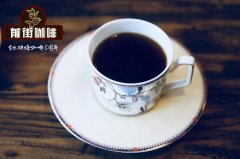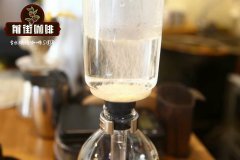Colombian saint Ario Manor yellow tin card hand brew coffee how to make coffee bitter

Professional coffee knowledge exchange more coffee bean information please follow the coffee workshop (Wechat official account cafe_style)
For many years in Colombia's boutique coffee farm, San Tuareo Manor has been a leader in technology and planting methods in the industry, the soul of which is the manor owner Camilo (Camilo Merizalde). Camilo was born in the Valle de Cauca Valley of Colombia. From an early age, he often went to the coffee farm near his home and watched adults process coffee, until he decided to study in the United States after graduating from high school. When he worked as a manager of a Colombian food and beverage factory in the United States after graduation and often had the opportunity to go back to his hometown of Colombia to purchase raw coffee beans, Camilo began to wonder why Colombian coffee could not be compared with Africa and Central America in terms of quality. Colombian coffee is often considered not to be one of the boutique coffee producers. During this period, Camilo began to study and read knowledge and books about coffee planting in the United States, hoping to grow stunning boutique coffee. At the same time, Camilo kept looking for estates with high-quality microclimate in Colombia, until 2000 he finally found the best farmland in the Colombian province of Cauca. At this time, Camilo immediately embarked on the transformation of the estate, large and small, ready to realize the ideal coffee farm concept in this manor named San Tuareo (Finca Santuario). The manor owner Camilo (Camilo Merizalde)
In the first step, Camilo decided to start with the improvement of the soil quality in the manor, by planting a large number of ash leaf plants to provide rich and natural nitrogen, while retaining many native plants and fruit trees to provide a diversified source of nutrients. Camilo then began to analyze the topography of the manor and divided it into 266 different micro-blocks. To make it easier for landowners to track and manage the growth of coffee and changes in microclimate in the park. The second step is to start selecting the varieties of coffee to be planted. Camilo made up his mind to choose the native varieties with low yield and good quality from the very beginning, and finally planted the first Tibica coffee tree in November 2002. until today, many varieties with excellent cup performance have been expanded in the garden of Chateau Santo Ali, such as Tibika, brothel, bourbon, pointed Bourbon and so on. As the estate is as high as 1950m above sea level, there is a large temperature difference between day and night and there is a lot of volcanic ash soil, so it is especially suitable for breeding these delicate varieties. The third step is to build their own washing treatment plant and exposure drying room, and the drying chamber has a lot of very advanced equipment in Colombia. Camilo first installed large exhaust fans on both sides of the drying chamber. The principle of exhaust fans is used to accelerate air flow, which can not only avoid excessive fermentation of raw beans, but also stably control the temperature of the exposure room. Camilo, who is full of experimental spirit, has improved the washing equipment in the washing plant through the experience of working with 2015WBC champion Sasa Sestic, using the design of stainless steel buckets and fillets to greatly improve quality stability and sweetness.
Through years of efforts, Camilo's first batch of San Tu Ali raw beans were officially exported in 2005, and today they have become the first choice for many contestants. In addition to WBC champion Sasa Sestic, Australian barista champion Matt Perger in 2013 also praised the raw beans of Saint Tu Ali'o Manor, and won the second place in WBC World Series by combining with EK43 bean mill that year. Camilo is constantly trying and experimenting with many new ways to improve the quality of coffee in his experience of working with these contestants. from the annual cup test, he will always find more flavor and unique varieties of the manor.
WBC champion Sasa Sestic
Coliombia Finca SANTUARIO Yellow Typica
Yellow iron pickup at Manor Santu Ario, Colombia
Farm: Finca SANTUARIO
Variety (S): Red Typica
Treatment: washing, later stage of sun exposure
Altitude: (1890-2010) 2050 m
Farm area: 135.4 hectares
Coffee planting area: 62.9 hectares
Owner: Camilo Merizald Camilo Merizald
City: Kali Cali
Area: test card
Country: Colombia
Flavor description: plum, chocolate, jasmine
How to make Colombian Coffee [San Tuareo Manor Yellow Iron pickup]?
Front Street Coffee hand reference: weigh 15g [San Tuareo Manor Yellow Iron pickup] coffee powder, pour into a grinder for medium grinding, the finished particles are slightly thicker than salt, we use BG bean mill to scale 5R (standard sieve pass rate 60%), water temperature 89 degrees, V60 filter cup extraction, recommended powder ratio around 1:15.
The hot water in the hand flushing pot draws a circle clockwise with the center of the filter cup. Start the time when brewing, brew the coffee to 30g in 15 seconds, then stop the water injection, and when the time is up to 1 minute, the second water injection. The second water injection is the same as before, draw a circle clockwise with the center of the filter cup, and the water flow should not rush to the place where the coffee powder is connected with the filter paper, so as not to produce channel effect.
Coffee powder to the outermost circle to set aside a circle, and then another circle to the middle, 2 minutes 20 seconds, to the coffee to 220g, brewing coffee is finished.
| Japanese Ice hand Chong [Santu Ali Manor Yellow Iron pickup]
Qianjie Coffee Ice hand [San Tuareo Manor Yellow Iron pickup] reference:
Colombian Coffee [Santu Ario Manor Yellow Iron pickup], light medium baking, BG bean grinder scale 5m (standard sieve pass rate 67%)
20 grams of powder, 150 grams of ice, 150 grams of hot water. The water temperature is 90 ℃ higher than the recommended normal hand flush, then 1 ℃ higher, the normal grinding small Fuji 3.5 scale, the ice hand flushing is slightly smaller than half a grid-small Fuji 3 scale, the recommended powder (water + ice) ratio is 1:15.
The amount of steaming water is 40 grams and the steaming time is 30 seconds.
Water injection by stages, 60 grams of water in the first section and 40 grams of water in the second section. Use a thin but high water injection column and stir hard to make the coffee powder fully tumble, but be careful that the water level is not too high and do not rush to the edge of the filter paper.
The whole extraction time is about two and a half minutes (close to the normal extraction time of 20 grams of powder).
END
Important Notice :
前街咖啡 FrontStreet Coffee has moved to new addredd:
FrontStreet Coffee Address: 315,Donghua East Road,GuangZhou
Tel:020 38364473
- Prev

What is a washing SL28/SL34? Introduction of Kenya Kanak treatment Plant
Professional coffee knowledge exchange more coffee bean information please follow the coffee workshop (Wechat official account cafe_style) the coffee-producing areas of Kenya are mainly concentrated in the plateau areas represented by Mount Mt.Kenya. Tropical climate, acid red volcanic soil provides a natural and suitable growth environment for coffee. It is most famous for its seven major producing areas, including Neri, Sika and Qianbu.
- Next

How do you usually drink Colombian hand-ground coffee in Colombian Tangbo Manor
Professional coffee knowledge exchange more coffee bean information please follow the coffee workshop (Wechat official account cafe_style) Colombian coffee probe: washed, with a mellow cream texture and citrus sour taste, the entrance is clean, with brown sugar sweet. Aromas of apple, citrus, caramel, Earl Grey Tea and a hint of plums, with fresh lemon acidity at the end and a long Col finish
Related
- Detailed explanation of Jadeite planting Land in Panamanian Jadeite Manor introduction to the grading system of Jadeite competitive bidding, Red bid, Green bid and Rose Summer
- Story of Coffee planting in Brenka region of Costa Rica Stonehenge Manor anaerobic heavy honey treatment of flavor mouth
- What's on the barrel of Blue Mountain Coffee beans?
- Can American coffee also pull flowers? How to use hot American style to pull out a good-looking pattern?
- Can you make a cold extract with coffee beans? What is the right proportion for cold-extracted coffee formula?
- Indonesian PWN Gold Mandrine Coffee Origin Features Flavor How to Chong? Mandolin coffee is American.
- A brief introduction to the flavor characteristics of Brazilian yellow bourbon coffee beans
- What is the effect of different water quality on the flavor of cold-extracted coffee? What kind of water is best for brewing coffee?
- Why do you think of Rose Summer whenever you mention Panamanian coffee?
- Introduction to the characteristics of authentic blue mountain coffee bean producing areas? What is the CIB Coffee Authority in Jamaica?

